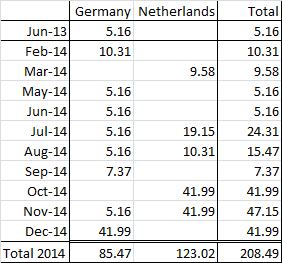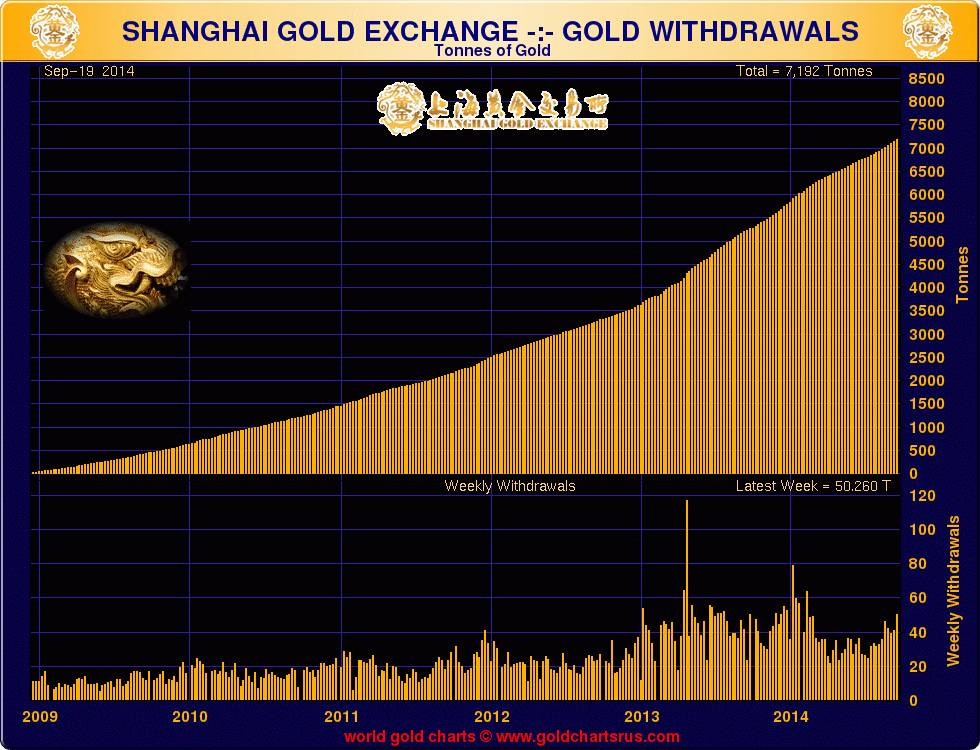The idea that gold would be released from its manipulated western shackles if only a physically settled Asian gold market could be established had its fullest expression in the 2011 Pan Asian Gold Exchange (PAGE)
hype/meme. PAGE
failed because of the political naivety of its exponents that "
there can only be one" in the Chinese gold market, namely, the Shanghai Gold Exchange (SGE).
In 2014 there was a flurry of activity in Asia with the SGE International Board, Singapore Exchange's (SGX)
gold kilobar contact and now, the CME's announcement of a
loco Hong Kong kilobar gold future contract.
The future for CME's new contract doesn't look bright, with Reuters
noting that the
"25 kg contract on the Singapore Exchange and the three new international contracts on the Shanghai Gold Exchange have failed to garner significant trading volumes." As Silver Watchdog
tweeted, SGE
announced they would be exempting international members and customers from all fees for six months
"with a view to encouraging international members and customers’ participation in trading and delivery activities on the International Board". Not exactly something you need to do if your contract is successful.
The CME's new contact seems pitched a little better than the SGX's, being in lots of one kilo (versus SGX's 25 kilos) and in USD per ounce (vs USD per gram). I would
note that CME's Comex contract, while for 100oz, can be settled in three kilobars (although it is a 99.5% purity contact compared to 99.99%) and this similarity would be behind the CME's
promoting of it
"providing spreading and arbitrage opportunities with other world gold markets virtually 24 hours a day", which seems a pitch directly targeted towards traders, not physical users.
However, no matter how well the contract specifications are designed, I think CME's new contract will go the same way as SGE and SGX and the reason is hinted at in the blurbs for the two contacts:
- SGE: "there is an increasingly compelling need for a transparent and centralized Asian price discovery platform for the kilobar gold market"
- CME: "will offer a liquid and cost-effective price discovery tool and a precise risk management instrument that accurately reflects the underlying kilo gold market in Asia"
A compelling need for price discovery by whom? The problem is that these exchanges are only looking at one side of the market - the demand side. Certainly importers, distributors and manufacturers large enough to trade a kilo contract would want more transparency on kilobar premiums. But it takes two to tango and these new contracts have little appeal to the supply side (which is not miners, BTW).
The mistake of the exchanges I think is that they thought that if they created a contract which appealed to the demand side, which is composed of many firms, that the supply side, which is composed of refiners but primarily bullion banks, would follow. The problem is that the supply side is dominated by a handful of firms and the banks, who intermediate most of the supply to consumers, are quite happy with an opaque kilobar premium market. Why would the banks want to disintermediate themselves out of this position?
The only way to break this would be for an exchange to get all of the demand side to insist on only buying via the exchange. Given the large number of participants, this is next to impossible as the bullion banks would hold out until defectors looked to get a jump on their competitors. I would note here that many of the consumers are also looking for finance/delay settlement with their purchases, something the exchanges don't offer. Bullion banks advantage is they can provide both physical and finance in one deal.
If we ignore the asymmetry of the number and size of the suppliers versus the consumers, there is also the practical realities of the kilobar market where demand at the various locations changes frequently. After doing a deal with a consumer, bullion banks can ship the physical from a refinery direct to the consumer. The exchange contracts however require physical to be shipped to their warehouses for settlement, and from there we have another shipment leg to the end consumer. This is not as efficient as an over the counter (OTC) trade where metal can be directed quickly to where it is needed. It is funny that in the CME's new contract FAQs that they acknowledge this sort of market structure when they say that
"with OTC clearing through CME ClearPort, you can continue to negotiate your own prices privately and conduct business off exchange" yet the contract they propose works against the current kilobar market structure.
The exchanges were given a hint of the problem by
this comment made at the LBMA Singapore conference (I didn't catch the person making it)
"whether a benchmark can compete or become established depends not just on its volume but also whether there a big enough premium/discount due to fundamental difference between the location and existing benchmark locations from a physical point of view". The brilliance of this comment is that the person making it knew that the loco difference between London and these Asian markets just isn't big enough to suck liquidity to the new venues - and knew that the exchanges didn't know.
The current OTC kilobar market is highly efficient with the spot price being traded basis the liquidity and depth of the London market and just the kilobar premium being negotiated separately on a client by client basis based on location/shipment cost, finance and purity (99.50% and 99.99%). Trying to compete against that while imposing a need to ship into a warehouse instead of directly to client, and require exchange settlement and clearing (with margin), while the client still has to deal with the bank anyway for finance, is a hard ask.
In the end China is probably best placed to win this game as they can force all of their consumers to trade through the SGE but as Adrian Ash at BullionVault
noted "only a truly liberalized gold trade, with foreign cash and gold flowing in...and out...right alongside China's domestic flows will challenge London's 300-year old dominance." And that is still some way off.




